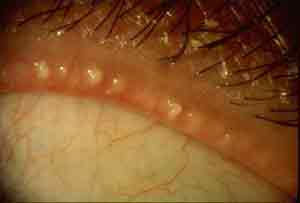Azithromycin May Combat Dry Eye
Findings published online first in JAMA Ophthalmology
 Meibomian gland dysfunction (MGD) is the leading cause of dry eye disease, which affects tens of millions of Americans. However, there is no FDA-approved treatment for MGD. Researchers from the Schepens Eye Research Institute/Massachusetts Eye and Ear and Harvard Medical School have just identified a potential therapy.
Meibomian gland dysfunction (MGD) is the leading cause of dry eye disease, which affects tens of millions of Americans. However, there is no FDA-approved treatment for MGD. Researchers from the Schepens Eye Research Institute/Massachusetts Eye and Ear and Harvard Medical School have just identified a potential therapy.
“We discovered that azithromycin, an antibiotic, can directly stimulate the function of human meibomian gland epithelial cells,” said First Author Yang Liu, M.D., a postdoctoral fellow at Schepens Eye Research Institute and Harvard Medical School. Their finding is outlined in a Research Letter that was published Online First in JAMA Ophthalmology.
This finding is very clinically significant, because topical azithromycin is the most commonly prescribed MGD treatment, but its use is ‘off-label,’ which means the drug’s efficacy has not yet been evaluated and approved by the Food and Drug Administration for patients with MGD. This antibiotic has been presumed to be effective because of its anti-inflammatory and anti-bacterial actions, which may suppress the MGD-associated conjunctival inflammation (i.e. posterior blepharitis) and growth of lid bacteria.
“We hypothesized that azithromycin could act directly on human meibomian gland epithelial cells to stimulate their differentiation, enhance the quality and quantity of their lipid production, and promote their holocrine secretion. Our results support this hypothesis,” said Senior Author David A. Sullivan, Ph.D., Senior Scientist and Margaret S. Sinon Scholar in Ocular Surface Research, Schepens Eye Research Institute and Associate Professor of Ophthalmology, Harvard Medical School.
The findings in this study may help lead to broader use of topical azithromycin as an FDA-approved, ‘on-label’ treatment to ameliorate the pathophysiology of MGD and its associated evaporative dry eye disease.
Source Newsroom: Massachusetts Eye and Ear Infirmary
Citations: JAMA Ophthalmology

